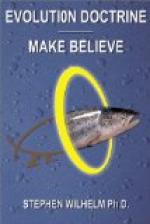No doubt most people feel justified in believing that the whole doctrine of evolution must stand or fall according to the cogency of the palaeontological evidences. Plain common sense says that the owners of shelly or bony fragments found in the deeply-laid strata of the earth must have lived countless years ago, and if the evolutionist asserts that primitive organic forms of ancient times have produced changed descendants of later times, it would seem that fossil evidence would be supremely and overwhelmingly important. It is true, of course, that this evidence is peculiarly significant, because in some ways it is more direct than that of the other categories already outlined. But it must not be forgotten that the doctrine is already securely founded upon the basic principles of anatomy and embryology. Science must treat the data of this category by different methods and must view them in different ways. Therefore we are interested in palaeontology because of the way it tells the story of evolution in its own words, and because we are justified in expecting that its account should include a description of some such order of events as that revealed by the developing embryos of modern organisms and that demonstrated by the comparative anatomy of the varied species of adult animals.
It is true that palaeontology gives direct testimony about the evolutionary succession of animals in geologic time. But we now know that embryology is even more direct in its proof that organic transformation is natural and real; while at the same time there is a completeness in the full series of developmental stages connecting the one-celled egg with the adult creature that must be forever lacking in the case of the fossil sequence of species. If paragraphs and pages are missing from the brief embryonic recapitulation, whole chapters and volumes of the fossil series have been lost for all time. The investigators whose task it has been to decipher the story of the earth’s evolution have had to meet numerous and exasperating difficulties which do not confront the embryologist and anatomist who study living materials. Nevertheless the library of palaeontological documents is one which has been founded for over a century, and it has grown fast during recent decades, so that consistent accounts may now be read of the great changes in organic life as the earth has altered and grown older. And in all this record, there is not a single line or word of fact that contradicts evolution. What definite evidence there is tells uniformly in favor of the doctrine, for it is possible, in the first place, to work out the order of succession of many of the great groups of animals, and this order is found to be the same as that established by the other bodies of evidence. Secondly, some fossil groups are astonishingly complete, so that the ancient history of a form like the horse can be written with something approaching fullness. Finally, the remains of certain animals have been found so situated in geological ways, and so constructed anatomically, that the zooelogist is justified in denoting them “missing links,” because they seem to have been intermediate between groups that have diverged so widely during recent epochs as to render their common ancestry scarcely credible.




